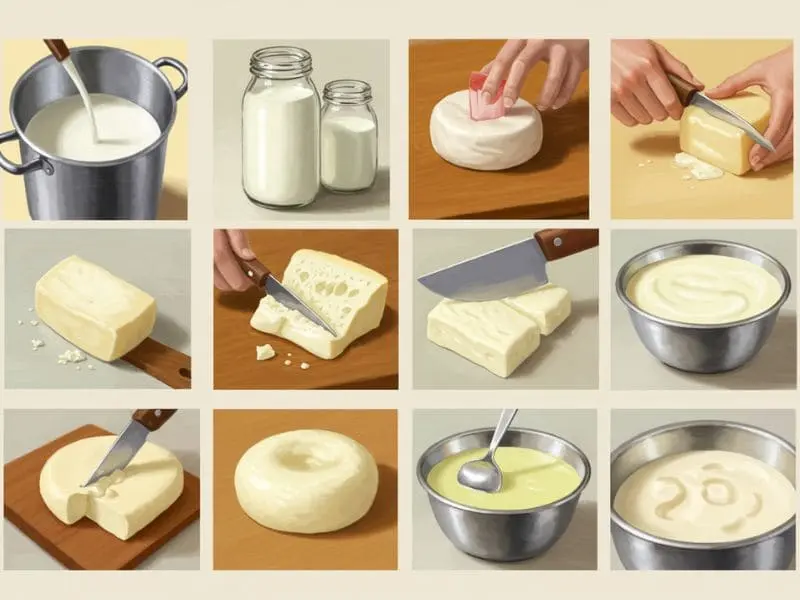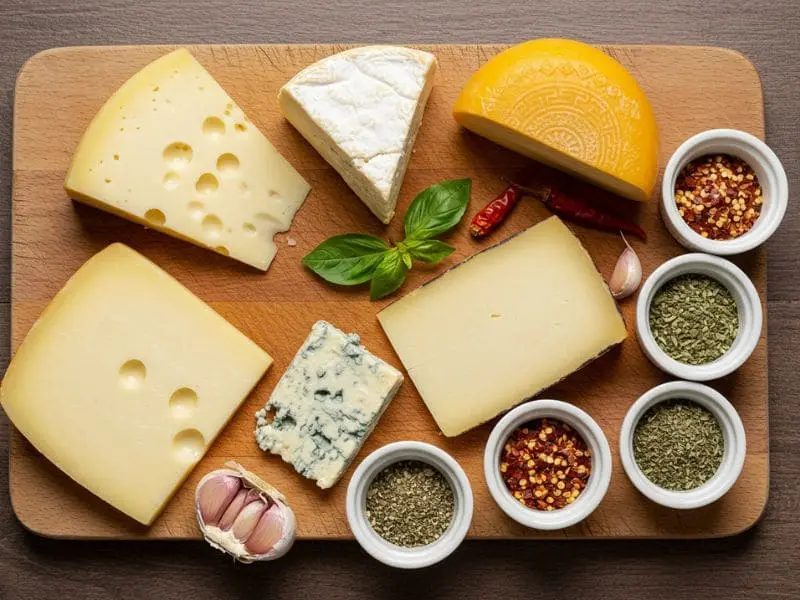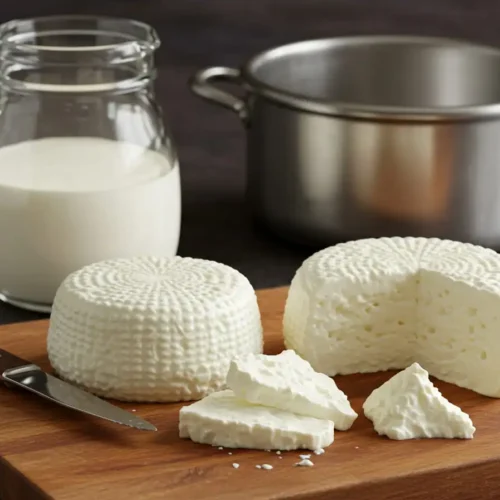Welcome to the delightful world of cheese! Have you ever found yourself savoring a creamy slice of brie or indulging in the sharpness of aged cheddar? Cheese is not just a food; it’s an experience that brings joy and comfort to our meals. Whether you’re a cheese aficionado or just starting to explore its many varieties, understanding what cheese is made of and how it’s crafted can deepen your appreciation for this culinary treasure.
Imagine hosting a gathering where a beautifully arranged cheese board steals the show, inviting your guests to enjoy not only its flavors but also its rich history. From the health benefits packed in every bite—like calcium for strong bones to protein for muscle growth—to the endless possibilities for pairing with fruits, nuts, and wines, cheese truly enhances our dining experiences.
In this recipe, we’ll uncover the secrets behind making your own delicious cheese at home, allowing you to experiment with flavors and textures that suit your palate. So, grab your apron and let’s dive into the creamy pleasure that awaits!
What is Cheese? Uncover the Secrets of Creamy Pleasure


Key Benefits of Cheese
Cheese is more than just a delicious addition to your meals; it’s a powerhouse of nutrition that offers a variety of benefits. Let’s explore why incorporating cheese into your diet can be both enjoyable and advantageous for your health.
Nutritional Powerhouse
Rich in Calcium: Cheese is an excellent source of calcium, which is essential for maintaining strong bones and teeth. Just a single serving can provide a significant portion of your daily calcium needs.
High-Quality Protein: Packed with protein, cheese supports muscle growth and repair. This makes it a fantastic option for those looking to boost their protein intake, especially after workouts.
Vitamins and Minerals: Cheese contains vital nutrients such as:
Vitamin B12: Important for nerve function and the production of red blood cells.
Vitamin A: Essential for vision and immune function.
Phosphorus: Works with calcium to build strong bones.
Health Benefits
Supports Bone Health: The combination of calcium, phosphorus, and protein in cheese helps maintain bone density and strength, reducing the risk of osteoporosis as we age.
Promotes Gut Health: Some cheeses, especially those made from raw milk, contain beneficial probiotics that can enhance gut health and digestion.
Boosts Immunity: The nutrients found in cheese can contribute to a stronger immune system, helping your body fend off illnesses.
Enjoying Cheese Responsibly
While cheese has many benefits, moderation is key. Here are some practical tips for enjoying cheese without overdoing it:
Choose Wisely: Opt for lower-fat varieties when possible, such as mozzarella or feta, to enjoy the flavor without excessive calories.
Pair with Healthy Foods: Combine cheese with fruits, vegetables, or whole grains to create balanced meals that enhance the overall nutritional value.
Mind Your Portions: A little goes a long way! Aim for about one ounce (the size of a pair of dice) per serving to keep your intake in check.
Conclusion
Incorporating cheese into your diet can be both delightful and beneficial. Whether you’re adding it to salads, using it in cooking, or enjoying it on its own, cheese offers a world of flavors and textures that can elevate any dish. So go ahead—embrace the creamy pleasure of cheese while reaping its health benefits!
What is Cheese Made Of?
Understanding what cheese is made of can deepen your appreciation for this beloved dairy product. Cheese is a delightful blend of simple ingredients transformed through a fascinating process. Let’s break it down together!
The Basic Ingredients
At its core, cheese is made from just three primary ingredients:
Milk: The foundation of all cheese, milk can come from various sources, including:
Cow: The most common type, producing a wide range of cheeses.
Goat: Known for its tangy flavor and creamy texture.
Sheep: Often richer and creamier, perfect for cheeses like feta and pecorino.
Cultures: These are beneficial bacteria added to milk to start the fermentation process. They help develop flavor and texture. Different cultures can yield different types of cheese, so this step is crucial!
Rennet: An enzyme that helps curdle the milk, separating it into solid curds and liquid whey. Rennet can be animal-based or vegetarian, so you can choose according to your dietary preferences.
The Cheese-Making Process
Now that we know the ingredients, let’s explore how they come together to create cheese:
Heating the Milk: Start by gently heating the milk to the desired temperature. This step helps activate the cultures.
Adding Cultures and Rennet: Once the milk is heated, add your chosen cultures and rennet. Stir gently, then let it sit undisturbed for a while to allow curds to form.
Cutting the Curd: After the curds have set, cut them into small pieces to release whey. The size of the curds affects the final texture of the cheese—smaller curds lead to firmer cheeses.
Cooking and Stirring: Heat the curds further while stirring gently. This step helps expel more whey and firm up the curds.
Draining the Whey: Once you achieve the desired consistency, drain off the whey using a fine mesh strainer or cheesecloth.
Salting and Shaping: Add salt to enhance flavor and act as a preservative. Then, shape your curds into molds or forms according to your recipe.
Aging (Optional): Depending on the type of cheese, aging can take place anywhere from a few days to several years. During this time, flavors develop and textures change, creating unique profiles.
Tips for Success
- Quality Matters: Use high-quality milk for the best results; fresh, organic milk will yield superior flavors.
- Experiment with Cultures: Don’t be afraid to try different cultures! Each one brings its unique characteristics to your cheese.
- Patience is Key: Cheese-making can be time-consuming, but it’s worth every moment when you taste your homemade creation!
Conclusion
Now that you know what cheese is made of and how it’s crafted, you’re ready to embark on your own cheese-making adventure! With just a few simple ingredients and some patience, you can create delicious cheeses tailored to your taste. So roll up your sleeves and get ready to enjoy the creamy rewards of your efforts!


How is Cheese Made?
Making cheese is a delightful blend of science and art, transforming simple ingredients into a culinary masterpiece. Whether you’re a novice or an experienced home cook, understanding the cheese-making process can enhance your appreciation for this versatile food. Let’s walk through the steps together!
The Cheese-Making Process
- Gather Your Ingredients: Start with high-quality milk, cultures, and rennet. Fresh, organic milk will yield the best flavors, so choose wisely!
- Prepare Your Equipment: Ensure you have all the necessary tools on hand:
- A large pot for heating the milk
- A thermometer to monitor temperature
- A slotted spoon for stirring
- Cheesecloth or a fine mesh strainer for draining whey
- Molds for shaping your cheese
- Heat the Milk: Pour your milk into the pot and gently heat it to the desired temperature (usually around 85°F to 90°F). Stir occasionally to prevent scorching.
- Add Cultures: Once the milk reaches the right temperature, sprinkle in your chosen cultures. These beneficial bacteria will start the fermentation process, developing flavor and texture. Let it sit for about 5-10 minutes to allow the cultures to activate.
- Introduce Rennet: Add rennet according to package instructions (usually about 1/4 teaspoon for a gallon of milk). Stir gently, then let it sit undisturbed for 30-60 minutes until curds form. This is where the magic happens!
- Cutting the Curds: After the curds have set and resemble a soft gel, use a long knife or curd cutter to slice them into small cubes. The size of your cuts will affect the final texture—smaller curds create firmer cheese.
- Cook the Curds: Gradually heat the curds while gently stirring. Aim for a temperature of around 105°F to 110°F over 30 minutes. This step helps expel whey and firm up the curds.
- Drain the Whey: Once cooked, pour the curds into a colander lined with cheesecloth to drain off excess whey. Gather the corners of the cloth and tie them together, allowing any remaining whey to drip out.
- Salting and Shaping: Once drained, transfer your curds to a bowl and mix in salt to taste (about 1-2 teaspoons). This not only enhances flavor but also acts as a preservative. Then, pack your curds into molds and press them down firmly.
- Aging Your Cheese: Depending on what type of cheese you’re making, you may want to age it for additional flavor development. Wrap your cheese in wax paper or cheese paper and store it in a cool environment (ideally around 50°F) for anywhere from a few days to several months.
Tips for Success
- Temperature Control: Keeping an eye on temperatures is crucial at every stage of cheese-making. Invest in a good thermometer to ensure accuracy.
- Experiment with Flavors: Don’t hesitate to add herbs, spices, or even infused oils during the salting stage for unique flavor profiles!
- Practice Patience: Cheese-making is as much about patience as it is about technique. Allowing time for fermentation and aging can significantly enhance flavor.
Conclusion
Now that you know how cheese is made—from heating milk to aging your final product—you’re well on your way to creating delicious cheeses at home! Embrace this rewarding process, and remember that each batch will be uniquely yours. So gather your ingredients, follow these steps, and enjoy the creamy satisfaction of homemade cheese!


Pro Tips and Variations
Creating your own cheese at home is a rewarding experience, and with a few pro tips and variations, you can elevate your cheese-making game to new heights! Let’s explore some practical advice and creative ideas to help you craft the perfect cheese.
Pro Tips for Cheese Making
- Start Simple: If you’re new to cheese making, begin with easier recipes like ricotta or paneer. These cheeses require fewer steps and less aging time, making them perfect for beginners.
- Use Fresh Ingredients: Quality matters! Always opt for fresh, high-quality milk and cultures. This will significantly impact the flavor and texture of your cheese.
- Maintain Cleanliness: Sanitize all your equipment before starting. Clean tools reduce the risk of unwanted bacteria affecting your cheese.
- Monitor Temperature Carefully: Use a reliable thermometer to keep track of temperatures throughout the process. Consistency is key in achieving the right texture and flavor.
- Patience is Key: Allow your curds to set for the recommended time without rushing the process. This patience will pay off with a better final product.
Creative Variations
Once you’ve mastered the basics, it’s time to get creative! Here are some fun variations to try:
- Herbed Cheese: Mix in fresh herbs like basil, chives, or dill during the salting stage for a burst of flavor. This is perfect for spreading on crackers or adding to salads.
- Spicy Cheese: For those who enjoy a kick, consider adding crushed red pepper flakes or jalapeños to your curds before shaping them. This adds an exciting heat that pairs beautifully with wine.
- Smoked Cheese: Experiment with smoking your cheese after it has aged. Use a stovetop smoker or a grill with wood chips for a rich, smoky flavor that will impress your guests.
- Flavored Cheeses: Infuse your cheese with unique flavors by adding ingredients like garlic, sun-dried tomatoes, or even fruit purees during the mixing stage.
Serving Suggestions
Once your cheese is ready, how you serve it can enhance the experience:
- Cheese Boards: Create an impressive cheese board by pairing your homemade cheese with complementary items like cured meats, nuts, fruits, and artisan crackers.
- Cooking Uses: Incorporate your cheese into recipes like lasagna, mac and cheese, or gourmet grilled cheese sandwiches for a delicious twist on classic dishes.
- Gifting: Homemade cheese makes a thoughtful gift! Package it nicely with some crackers or a bottle of wine for a delightful present.
Conclusion
With these pro tips and creative variations in mind, you’re well-equipped to embark on your cheese-making journey! Remember that each batch is an opportunity to experiment and discover new flavors. Enjoy the process, share your creations with friends and family, and most importantly—have fun in the kitchen!


How to Serve & Store Cheese Properly
Once you’ve created your delicious homemade cheese, knowing how to serve and store it properly is essential for maintaining its flavor and texture. Let’s explore some friendly tips to ensure your cheese remains fresh and delightful!
Serving Cheese
Bring It to Room Temperature: For the best flavor experience, take your cheese out of the refrigerator about 30-60 minutes before serving. This allows the cheese to warm up, enhancing its natural flavors and making it more enjoyable.
Craft a Beautiful Cheese Board:
Variety is Key: Include a mix of textures and flavors—soft cheeses like brie, hard cheeses like cheddar, and crumbly varieties like feta.
Accompaniments: Pair your cheese with:Fresh Fruits
Presentation Tips: Arrange everything on a wooden board or platter. Consider using small labels to identify each type of cheese, adding an elegant touch.
Pairing Suggestions:
Wine Pairings: Light cheeses pair wonderfully with white wines like Sauvignon Blanc, while robust cheeses complement red wines such as Cabernet Sauvignon.
Condiments: Serve honey, fig jam, or spicy mustard on the side to elevate the tasting experience and provide exciting flavor contrasts.
Storing Cheese
Proper storage is crucial to preserving the quality of your homemade cheese. Here are some tips to keep it fresh:
- Wrap It Right:
- Use wax paper or parchment paper for soft cheeses to allow them to breathe while retaining moisture.
- For harder cheeses, wrap them in plastic wrap or store them in an airtight container to prevent drying out.
- Refrigeration Tips:
- Store cheese in the vegetable crisper drawer of your refrigerator, which helps maintain optimal humidity levels.
- Keep cheese away from strong-smelling foods; it can easily absorb odors that alter its taste.
- Freezing Cheese:
- If you have excess cheese, consider freezing it! Wrap it tightly in plastic wrap and place it in a freezer-safe bag. Remember that freezing may change the texture slightly, so it’s best used in cooked dishes after thawing.
- Check for Freshness:
- Before using stored cheese, inspect it for any signs of spoilage such as unusual odors or mold (unless it’s a type that’s supposed to be moldy). If anything seems off, it’s safer to discard it.
Conclusion
By following these serving and storage tips, you can ensure that your homemade cheese remains fresh and flavorful for all occasions. Whether you’re hosting a gathering or enjoying a quiet night at home, presenting your cheese beautifully will enhance your culinary experience. So gather your favorite accompaniments, serve with flair, and savor every creamy bite!


Conclusion
Congratulations on embarking on your cheese-making journey! By now, you’ve learned about the delightful world of cheese—from understanding its basic ingredients to mastering the art of serving and storing it. Let’s take a moment to reflect on the key points and inspire you to continue exploring this culinary adventure.
The Joy of Homemade Cheese
Making cheese at home is not just about creating a delicious product; it’s about the experience. Here are a few reasons why you should embrace this rewarding endeavor:
- Creativity: Cheese-making allows you to experiment with flavors, textures, and techniques. Don’t hesitate to try new herbs, spices, or even infusions to create a cheese that’s uniquely yours.
- Satisfaction: There’s nothing quite like the pride of serving cheese that you’ve made yourself. It’s a conversation starter and a testament to your culinary skills.
- Health Benefits: Homemade cheese can be tailored to your dietary preferences, allowing you to control ingredients and avoid preservatives found in many store-bought options.
Key Takeaways
As you continue your cheese-making journey, keep these essential tips in mind:
- Start Simple: If you’re new to cheese making, begin with easy recipes like ricotta or mozzarella before progressing to more complex cheeses.
- Quality Ingredients Matter: Always use high-quality milk and cultures for the best flavor and texture.
- Patience is Key: Cheese-making requires time and attention. Allow your curds to set properly and don’t rush the aging process.
- Experiment and Enjoy: Don’t be afraid to try different combinations of flavors and techniques. Each batch can be a new adventure!
Final Thoughts
We hope this guide has inspired you to dive into the world of cheese making with confidence. Whether you’re hosting a gathering or enjoying a quiet evening at home, homemade cheese can elevate any meal. So gather your ingredients, invite some friends over, and share the joy of your culinary creations!
Remember, every great chef started somewhere—so keep experimenting, learning, and enjoying the creamy pleasures of cheese! Happy cheese making!


Homemade Cheese
Ingredients
- 2 gallons of fresh whole milk cow, goat, or even store-bought pasteurized milk will work
- ¼ cup apple cider vinegar white vinegar or lemon juice can also be used
Equipment Needed (Bulleted):
- Large pot
- Thermometer optional, but recommended
- Strainer
- Cheesecloth optional, for a drier cheese
- Ladle
- Wooden spoon
- Measuring cups and spoons
Instructions:
- Heat the Milk: Pour the milk into a large pot and heat over medium heat stirring occasionally to prevent scorching. Heat to 175°F (80°C). If you don’t have a thermometer, heat until the milk is steaming and just about to simmer.
- Add the Acidifier: Keep the heat on and add the apple cider vinegar or other acidifier. Stir gently for about 10 minutes, until the curds begin to form and separate from the whey. The whey will have a slightly greenish hue.
- Strain the Curds: Line a strainer with cheesecloth if desired, for a drier cheese and set it over a bowl. Carefully pour the curds and whey into the strainer.
- Drain the Cheese: Let the curds drain for at least 30 minutes. The longer you drain the drier and firmer the cheese will be. For a softer, ricotta-style cheese, drain for a shorter time. For a firmer, queso fresco-style cheese, drain longer and press gently with a spoon to remove more whey.
- Enjoy: The cheese is now ready to eat! Enjoy it fresh on its own or use it in your favorite recipes.
Tips and Notes:
- Milk Choice: Whole milk will produce the creamiest cheese.
- Acidifier Amount: The amount of acidifier needed may vary slightly depending on the milk. Start with 1/4 cup and add more if needed a tablespoon at a time, until the curds separate clearly from the whey. Be careful not to add too much.
- Whey Uses: Don’t discard the whey! It can be used in baking smoothies, soups, or fed to pets.
- Variations: Add herbs spices, or salt to the cheese after draining for added flavor.
Notes
- Calories: 150
- Total Fat: 10g
- Saturated Fat: 6g
- Cholesterol: 30mg
- Sodium: 200mg
- Total Carbohydrates: 1g
- Dietary Fiber: 0g
- Sugars: 0g
- Protein: 12g


FAQs
As you embark on your cheese-making adventure, you might have some questions along the way. Here are some frequently asked questions that can help clarify common concerns and enhance your experience in the kitchen.
1. What type of milk is best for cheese making?
Fresh, High-Quality Milk: The best milk for cheese making is fresh and high-quality. You can use cow, goat, or sheep milk, depending on your preference. Whole milk is ideal for a richer flavor and creamier texture.
2. Can I use store-bought milk?
Yes, but with Caution: You can use store-bought milk, but avoid ultra-pasteurized milk as it may not curdle properly. Look for pasteurized whole milk for the best results.
3. How long does homemade cheese last?
Storage Matters: The shelf life of your homemade cheese depends on the type. Soft cheeses typically last about 1 week in the refrigerator, while hard cheeses can last several weeks to months if stored properly.
4. What should I do if my cheese doesn’t curdle?
Check Your Ingredients: If your cheese doesn’t curdle, it could be due to old or ineffective rennet or cultures. Ensure your ingredients are fresh and follow the recipe closely.
5. Can I flavor my cheese?
Absolutely!: Flavoring your cheese is a fantastic way to personalize it. You can add herbs, spices, garlic, or even fruit during the mixing stage to create unique flavors.
6. Is it safe to eat moldy cheese?
Depends on the Type: Some cheeses are meant to be moldy (like blue cheese), while others should not have mold. If you see mold on a non-moldy cheese, it’s best to discard it to avoid potential food safety issues.
7. What equipment do I need to make cheese?
Basic Tools: You don’t need fancy equipment! Essential tools include a large pot, thermometer, slotted spoon, colander, and cheesecloth. As you advance, you might consider investing in molds and presses.
Conclusion
We hope these FAQs help answer some of your burning questions about cheese making! Remember that every cheesemaker has their own journey filled with experimentation and learning. Don’t hesitate to reach out for guidance or share your experiences with fellow cheese enthusiasts.
Happy cheese making! Enjoy the process and the delicious results that come from your efforts!

